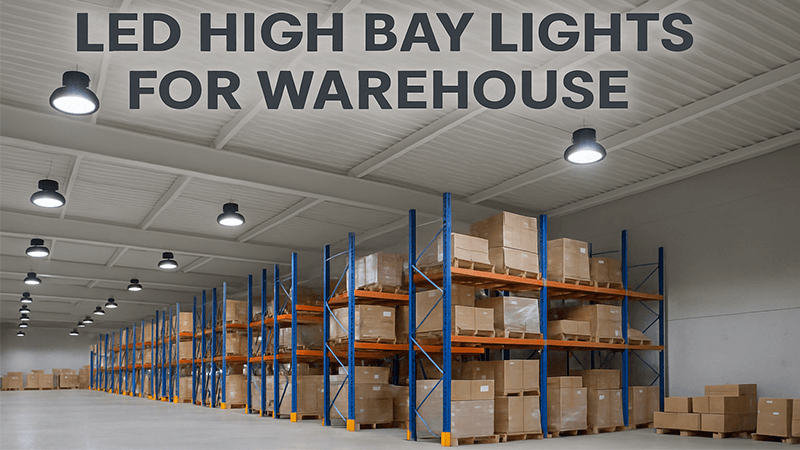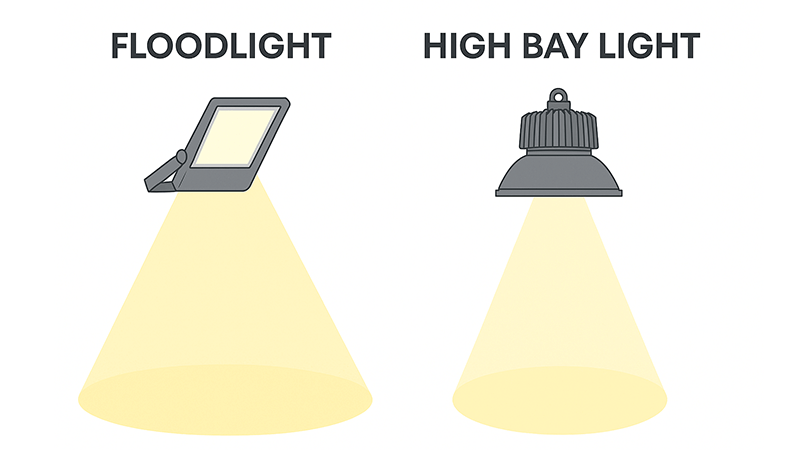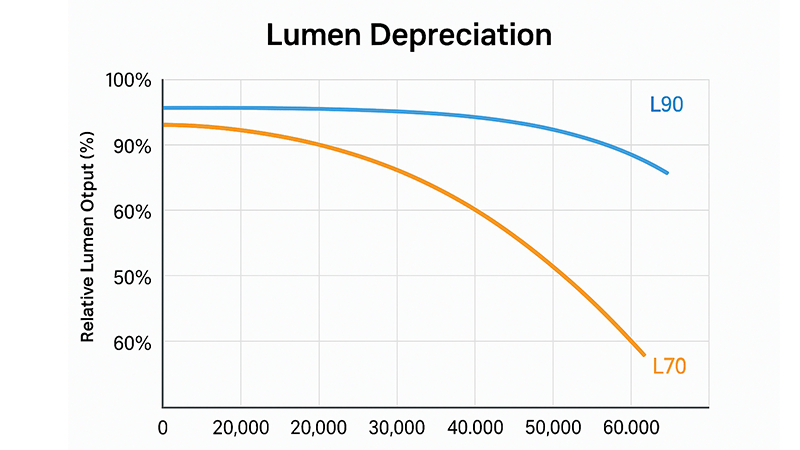Last Updated on: September 1, 2025Struggling with dark spots and high energy bills in your warehouse? Poor lighting slows down work and creates safety risks. The right lighting choice can solve these problems effectively.
For large warehouses, LED high bay lights are almost always a better choice than floodlights. High bays are designed to distribute light evenly from high ceilings downwards, minimizing glare and illuminating large floor areas and vertical racks efficiently, which is exactly what a warehouse needs.

When I started in the lighting industry, many clients would ask for "floodlights" for their large indoor spaces. It’s an understandable request. The term sounds powerful, like it will flood the entire area with light. However, using the wrong tool for the job can lead to wasted money, unhappy workers, and even safety hazards. As a purchasing manager, I know you need to get the specifications right the first time to protect your investment and ensure operational excellence. Let’s dive deeper into why the specific type of light matters so much and what you should really be looking for.
What is the best lighting for a warehouse?
Are you finding that your warehouse lighting creates harsh glare in some spots and deep shadows in others? This uneven lighting makes picking items difficult and can even be dangerous for forklift operators.
The best lighting for a warehouse is typically an LED High Bay fixture. Unlike floodlights, which cast a wide, often uncontrolled beam, high bay lights are engineered to direct light downwards efficiently from high mounting points, ensuring uniform illumination on both floors and vertical rack faces.

When clients ask me for warehouse lighting, my first step is to steer them away from the idea of traditional floodlights. The core of the issue lies in the light distribution pattern. Think of it as the difference between a shotgun and a rifle. A floodlight is like a shotgun, scattering light everywhere in a wide, symmetrical pattern. This is great for illuminating a building facade or a sports field, but inside a warehouse, a lot of that light gets wasted hitting the tops of racks or creating blinding glare for workers looking up. This is what we call the "Asymmetrical vs. Symmetrical Trap."
For a warehouse, you need a rifle. You need precise light control. This is where specialized high bay lights come in.
Understanding Light Distribution
The key is choosing the right optical distribution for each specific area of your warehouse. Not all areas are the same.
- Open Areas: For large, open floor spaces used for staging or bulk storage, a UFO-style high bay with a wider, yet controlled, symmetrical beam (like 90 or 120 degrees) works perfectly. It pushes a strong, even circle of light straight down.
- Aisles: For long, narrow aisles between tall racking systems, you need a different solution. Using a standard UFO high bay here is inefficient. Much of the light spills onto the top of the racks. Instead, you should use a Linear High Bay with an asymmetrical or oval-shaped light distribution. These fixtures are specifically designed to throw light forwards and backwards down the aisle, illuminating the vertical faces of the racks where product labels are.
I once had a client in the UAE who insisted on using standard floodlights for his entire 20,000-square-meter facility, including the aisles. He wanted the cheapest "per unit" price. Six months after installation, he called me. His forklift operators were complaining of headaches from the glare, and the picking error rate had increased by 15% because the lower rack labels were in shadow. We had to replace all the aisle lighting with proper linear high bays. The initial "savings" were completely wiped out by the cost of rework and lost productivity. This experience taught me a valuable lesson: matching the light distribution to the space is not a recommendation; it’s a requirement for a successful project.
Which type of lighting system is best suited for large commercial spaces?
Are you focused only on the upfront cost and wattage of your lights? Many purchasing managers fall into this trap, overlooking hidden factors that impact productivity and employee well-being, leading to long-term costs.
The best lighting system for large commercial spaces prioritizes light quality, not just quantity. A system with high Color Rendering Index (CRI) and flicker-free technology will boost worker safety, accuracy, and comfort, delivering a much higher return on investment than a cheaper, lower-quality alternative.

As a purchasing manager, you are trained to look at the numbers. Lumens per watt (lm/W) is a common metric for efficiency, and it is important. But in my years of manufacturing, I’ve seen that focusing only on this metric can be a huge mistake. The real value of a lighting system, especially in a place where people are actively working, comes from the quality of the light itself. Two key factors that are often ignored are the Color Rendering Index (CRI) and flicker.
Let’s break down why these are critical for a space like a warehouse or a large shop.
The Hidden ROI of Light Quality
The light you provide directly affects your team’s performance. It’s not just about being able to see; it’s about how well they can see.
-
Color Rendering Index (CRI): CRI is a scale from 0 to 100 that measures how accurately a light source shows the true colors of an object compared to natural sunlight. A low CRI light (below 70) can make reds look brown or blues look gray. In a warehouse, this is a recipe for disaster. Imagine a worker trying to distinguish between boxes with slightly different colored labels for different SKUs. Under low CRI light, the risk of a picking error skyrockets. For any commercial space where color accuracy matters—from logistics to retail—I always insist on a CRI of 80 or higher. The small additional cost per fixture pays for itself quickly by reducing errors and returns.
-
Flicker Mitigation: Most people don’t consciously see the flicker from LED lights, but the brain can perceive it. This invisible flicker, especially in low-quality fixtures, can cause eye strain, headaches, and even migraines for sensitive individuals over a long shift. It can also create a dangerous stroboscopic effect on rotating machinery, making moving parts appear to be stationary or moving slower than they are. When sourcing lights, you should ask the supplier for data on flicker percentage or IEEE 1789 compliance. A truly flicker-free light is a direct investment in your employees’ health and safety, reducing absenteeism and improving concentration.
A few years ago, we supplied lights for a large textile factory. We recommended our flicker-free, 90+ CRI fixtures. The purchasing manager was skeptical and almost chose a cheaper competitor. We convinced him to run a pilot in one section of the factory. After one month, the section manager reported a noticeable drop in mis-picked fabric rolls and told us the workers felt "more alert" at the end of their shifts. They ended up retrofitting the entire facility with our high-quality lights.
| Feature |
Low-Quality System (e.g., <70 CRI, High Flicker) |
High-Quality System (e.g., 80+ CRI, Flicker-Free) |
Impact on Warehouse Operations |
| CRI |
Colors appear dull and distorted. |
Colors appear true and vibrant. |
Reduces mis-picks, improves inspection accuracy, enhances safety. |
| Flicker |
Can cause headaches, eye strain, fatigue. |
No perceptible flicker. |
Increases employee comfort, reduces health complaints, improves focus. |
| Efficiency |
Might have high lm/W. |
Can also have high lm/W. |
Efficiency is a baseline; quality is what drives productivity. |
| ROI |
Lower upfront cost, higher long-term operational costs. |
Higher upfront cost, lower TCO due to fewer errors. |
The best investment considers human factors, not just watts. |
How many lumens do I need for a warehouse light?
Are you just calculating the total lumens you need based on a simple chart? This common shortcut can leave your facility underlit in a few years, forcing expensive, early replacements or additional fixtures.
The number of lumens needed depends on ceiling height and the task being performed, but the crucial metric is lumen maintenance (e.g., L90 vs. L70). Focusing on a fixture with a better L90 rating ensures long-term performance and a lower total cost of ownership (TCO).

Every lighting project starts with the question, "How much light do I need?" There are standard guidelines, of course. For general storage areas, around 300 lux (about 30 lumens per square foot) might be enough. For packing and shipping areas, you might need 500 lux or more. But this is only half the story. The biggest mistake I see purchasing managers make is ignoring lumen depreciation. All lights dim over time. The real question is not just how bright a fixture is today, but how bright it will be in five or ten years.
This is where understanding the difference between L70 and L90 lifetime ratings becomes critical to making a smart financial decision.
The L90 vs. L70 Deception in TCO
These "L" ratings tell you about a light’s longevity. They are not about when the light fails completely, but about when its light output drops to a certain percentage of its initial brightness.
- L70: This means the fixture’s output is projected to drop to 70% of its initial lumens after a certain number of operating hours (e.g., L70 at 50,000 hours). At this point, the light is noticeably dimmer, and for many applications, it’s considered the end of its useful life.
- L90: This means the fixture’s output is projected to drop to only 90% of its initial lumens after a specified number of hours. An L90-rated fixture maintains its brightness for much, much longer than an L70-rated one.
A cheaper fixture might have an impressive L70 rating of 100,000 hours. A higher-quality, more expensive fixture might be rated L90 at 50,000 hours. On the surface, the L70 fixture looks better. But it’s a deception. The L70 fixture will be significantly dimmer for half of its life. The L90 fixture will provide consistent, near-original brightness for its entire rated life. For a warehouse, this means you don’t have to over-light the space initially to compensate for future dimming, saving energy from day one. It also means you won’t have to replace the fixtures nearly as soon.
Let’s look at a simple Total Cost of Ownership (TCO) comparison for 100 fixtures over 10 years (approx. 50,000 hours of use).
| Cost Factor |
Fixture A (Cheaper L70) |
Fixture B (Quality L90) |
Comments |
| Unit Price |
$100 |
$130 |
Fixture A seems cheaper at first. |
| Initial Purchase Cost |
$10,000 |
$13,000 |
An initial $3,000 difference. |
| Light Output at 50,000 hrs |
70% of initial |
90% of initial |
Fixture A is now noticeably dim. |
| Need for Replacement? |
Yes, at ~50,000 hours |
No, still functional |
This is the key difference. The light level from A is now too low. |
| Cost of Replacement Labor |
$5,000 |
$0 |
Labor and equipment rental to replace fixtures at height is expensive. |
| Total Cost over 10 Yrs |
$15,000 |
$13,000 |
Fixture B provides a lower TCO and better, more consistent light. |
As you can see, the fixture that looked 30% more expensive upfront is actually the more economical choice in the long run. When you’re managing a budget, looking at the TCO, not just the purchase price, is the key to making a truly sound investment.
What is the best lighting for a big shop?
Do you think installing bright lights is the end of the project? In today’s world, a "set it and forget it" lighting system is a missed opportunity for massive energy savings and operational flexibility.
The best lighting for a big shop or warehouse is a smart, controllable system. Using technologies like motion sensors and daylight harvesting is the new frontier, but ensuring these components are interoperable through open standards like DALI or Zigbee is essential to avoid vendor lock-in.

The biggest leap forward in lighting over the past decade hasn’t just been the efficiency of the LEDs themselves, but our ability to control them. A large warehouse is a dynamic environment. Aisles are empty for long periods. Areas near large windows or skylights don’t need artificial light on a sunny day. A static lighting system that runs at 100% power all day is incredibly wasteful. This is where granular control becomes your most powerful tool for cutting operational costs.
However, implementing controls brings a new challenge: interoperability.
Granular Control and the Importance of Interoperability
Smart controls allow you to treat your lighting not as a single utility, but as a flexible system that adapts to your needs in real-time.
- Motion Sensors: Also known as occupancy sensors, these are the most common form of control. In a warehouse aisle, lights can be set to 30% brightness when empty and instantly ramp up to 100% when a person or forklift enters. This single feature can cut lighting energy use in low-traffic areas by up to 70%.
- Daylight Harvesting: Photosensors installed near windows or skylights measure the amount of natural light coming in. The control system then automatically dims the nearby electric lights to maintain a consistent light level, saving energy without anyone noticing a difference.
- Zoning and Scheduling: You can group lights into zones and set schedules. For example, during a second shift that only uses the shipping area, you can schedule the lights in the rest of the warehouse to turn off completely.
The problem is that many manufacturers create their own proprietary control systems. If you buy fixtures and sensors from Manufacturer A, you are locked into their ecosystem. If they go out of business or discontinue a product, you have a huge problem. This is where interoperability is king. By specifying an open protocol like DALI (Digital Addressable Lighting Interface) or a wireless standard like Zigbee, you ensure that you can use fixtures, sensors, and controllers from different manufacturers. They will all speak the same language. This gives you, the purchaser, immense power. It future-proofs your investment, promotes competition among suppliers, and gives you the flexibility to upgrade or replace individual components as needed without having to overhaul the entire system.
I always advise my clients to write "DALI-compatible" or "Zigbee 3.0 certified" directly into their project specifications. It forces suppliers to provide flexible, non-proprietary solutions and protects the client’s long-term interest. Building a smart lighting system is easy, but building a smart and open system is the mark of a truly strategic investment.
Conclusion
Choose LED high bays over floodlights, look beyond lumens to light quality and controls, and focus on Total Cost of Ownership with L90 standards for the best long-term warehouse investment.